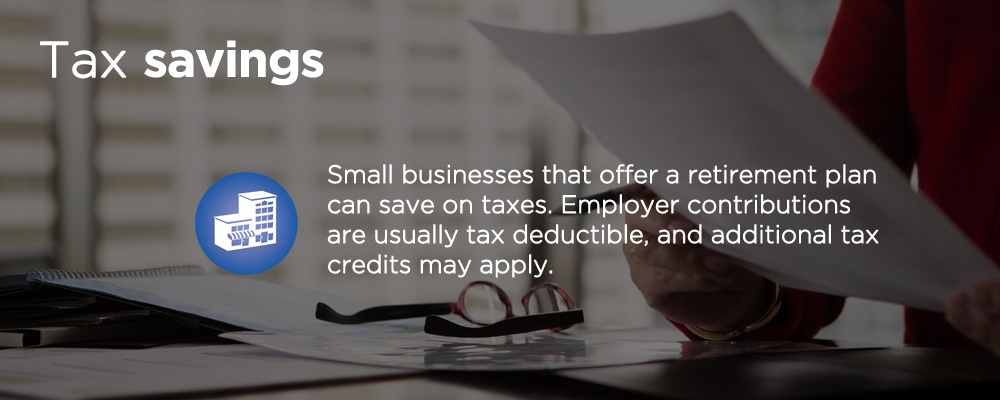
Small business owners wear a lot of hats. Decisions on health care plans, retirement plans and other benefits are often left solely to the owner.
Offering a small business retirement plan to employees isn’t always on the radar. A study by LIMRA showed that only 42 percent of small businesses offered retirement plans – despite the fact these plans not only help employees but offer great benefits to the employer, too.
“From the perspective of the employer/business owner, it’s the ability to put money away for retirement on a tax-advantaged basis,” says Jerry Kalish, a small business benefit services consultant in Chicago. “This is important, because business owners are the least prepared of all people for retirement, even less so than their employees, according to studies.”
Another advantage of offering a retirement plan is helping the owner attract, retain and motivate employees, Kalish says.






How to pick a retirement plan
When an employer is looking into employee retirement plans, a retirement planner will ask a number of questions:
- What are you trying to accomplish in starting a retirement plan? Do you want a savings vehicle primarily for the business owner or for the employee?
- What are the company’s financial limitations? A startup, for example, may not be able to provide a company match to employee savings.
- What restrictions do you want on the plan? Do you want to add a vesting schedule, for example, to encourage employees to stay longer in order to access the employer match?
- Do you want employees to be able to contribute to the plan?
Depending on your answers, a retirement specialist can steer you toward the appropriate small business retirement plan options.
Here are the most popular retirement plans for small businesses, according to Jeff Cutter, CPA, PFS, a financial planner in Mansfield, Mass.
Individual 401(k)
For business owners who employ themselves, and possibly a spouse, the Individual 401(k) helps maximize retirement contributions.
2020 Contribution Limits:
- Employees can contribute up to $19,500 in tax-deferred income if they’re under age 50. Those 50 or older can contribute up to $26,000 per year.
- Employers can contribute up to 25 percent of the employees’ compensation. The combined employer/employee contribution can’t be more than $57,000 a year annually for those 49 and under, or $63,500 for those 50 and older.
Administration:
There’s no administrative hassle. The Individual 401(k) is easy, with no cost to open, and with minimal administrative fees. If the account has over $250,000, you need to file form 5500 with the IRS, otherwise there’s no yearly paperwork. Plus, there’s unlimited investment options.
Traditional 401(k)
Companies with 25 or more employees might opt for a traditional 401(k).
2020 Contribution Limits:
- Employees can, as with the individual 401(k), contribute up to $19,500 in tax-deferred income if under age 50, and employees over 50 can contribute up to $26,000.
- Employers can contribute up to 25 percent of the employees’ compensation. The combined employer/employee contribution can’t be more than $57,000 a year annually for those under 50, or $63,500 for those 50 and older.
Administration:
A traditional 401(k) plan involves more administrative and financial burden for the employer.
The cost to administer the plan rises based on the number of employees. The company needs a formal plan document and a custodian to administer it. It can cost several thousand dollars to create the plan and the IRS 5500 form must be filed annually.
Good to know:
In addition to many investment options, employees can often take out loans against their 401(k) balances. Some employers encourage employee contributions by offering a match, adding a vesting schedule to ensure that employees stay longer.
Simple IRA
The Simple IRA is a good plan for companies with fewer than 100 employees, says Cutter.
2020 Contribution Limits:
- Employees can contribute up to $13,500 in tax-deferred income if under age 50 and up to $16,500 annually for those 50 or older.
- Employers are usually required to match the employee contributions, up to 3 percent of their compensation. “That’s usually the most attractive piece of this plan,” according to Cutter. “Now the employer is helping to contribute to the employee’s retirement.” Employers can instead contribute 2 percent of the employee’s salary if they don’t match.
Administration:
The cost to set up and administer this plan is minimal. Employers don’t need to file IRS form 5500.
Good to know:
Contributors cannot withdraw Simple IRA funds before age 59 1/2 without a penalty. You can withdraw the money at any time, but prior to age 59 1/2 there’s a 10 percent penalty. If you withdraw it within the first two years, the penalty is 25 percent.
SEP IRA
The SEP IRA is a plan for companies with only one or two employees. It’s geared toward small business owners who want to save the maximum amount for retirement, says Cutter.
2020 Contribution Limits:
- Employees do not contribute to this plan.
- Employers contribute up to 25 percent of the employee’s compensation to the plan, up to $57,000 a year. They must contribute the same percentage for each employee.
Administration:
The SEP IRA is easy to establish and maintain. There are usually no fees or expenses.
Good to know:
This plan is good even if the employer has a non-family member as an employee, says Cutter.
Learn more about Nationwide retirement plan options and the benefits they can offer your small business.
NFW-6742AO.2



